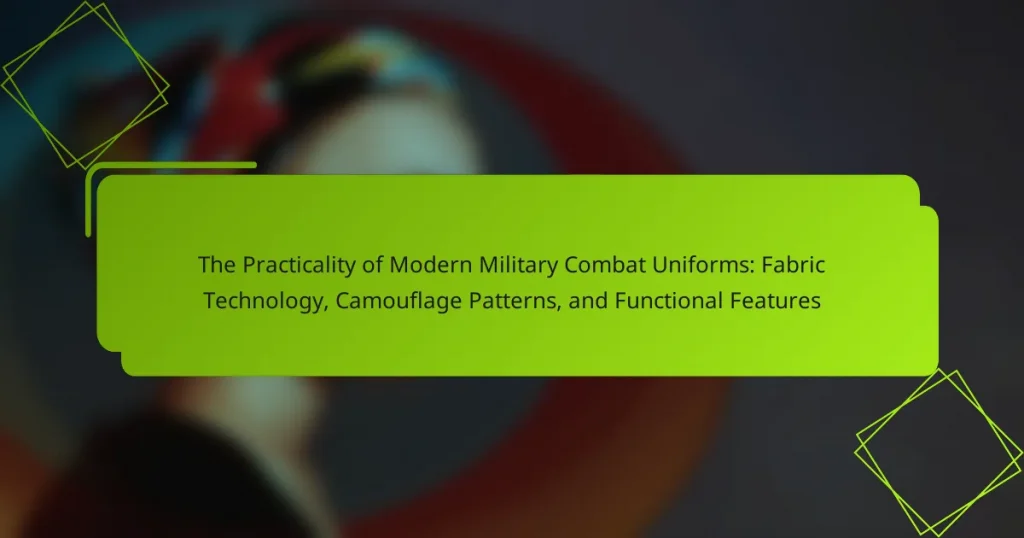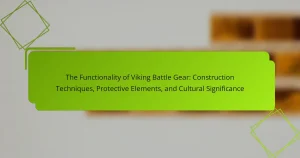Modern military combat uniforms are designed for optimal functionality, durability, and adaptability in various operational environments. These uniforms utilize advanced fabric technology that enhances comfort through moisture-wicking properties and insulation for temperature regulation. Specialized camouflage patterns are tailored to blend into specific terrains, improving concealment and operational effectiveness. Key features include multiple pockets for equipment storage and lightweight materials that facilitate mobility. Emerging trends in uniform technology focus on smart fabrics, lightweight armor, adaptive camouflage, and sustainable materials, all aimed at enhancing soldier performance and safety in combat situations.

What are the key characteristics of modern military combat uniforms?
Modern military combat uniforms are designed for functionality, durability, and adaptability. They typically feature advanced fabric technology that enhances comfort and moisture-wicking properties. Camouflage patterns are tailored to specific environments, improving concealment in various terrains. Functional features include multiple pockets for equipment storage and reinforced areas for increased wear resistance. Additionally, uniforms often incorporate lightweight materials to facilitate mobility. Many designs also integrate modular components, allowing soldiers to customize their gear based on mission requirements. These characteristics collectively enhance operational effectiveness and soldier safety in combat situations.
How has fabric technology evolved in military combat uniforms?
Fabric technology in military combat uniforms has evolved significantly over the years. Early uniforms primarily used cotton and wool, which offered limited durability and protection. Modern advancements now incorporate synthetic fibers such as nylon and polyester. These materials provide enhanced strength, moisture-wicking properties, and quick-drying capabilities.
Additionally, innovations like ripstop fabric have increased resistance to tearing and abrasion. The integration of flame-resistant materials has improved soldier safety in combat situations. Furthermore, advancements in camouflage technology have led to the development of adaptive patterns that blend better with various environments.
Research indicates that the use of advanced textiles can also improve thermal regulation and comfort for soldiers. Overall, these technological advancements have resulted in uniforms that are lighter, more durable, and better suited for the demands of modern warfare.
What types of fabrics are commonly used in modern military uniforms?
Modern military uniforms commonly use fabrics like nylon, polyester, and cotton blends. These materials provide durability and comfort. Nylon is lightweight and resistant to abrasion. Polyester offers moisture-wicking properties and quick-drying capabilities. Cotton blends enhance breathability and softness. Additionally, some uniforms incorporate ripstop fabric for added tear resistance. The combination of these fabrics ensures that uniforms meet the demands of various environments and operations.
How do these fabrics enhance performance and durability?
These fabrics enhance performance and durability through advanced material technology. They are often made from high-strength synthetic fibers, which provide superior resistance to wear and tear. This resistance is crucial in combat situations where durability is essential. Additionally, many of these fabrics feature moisture-wicking properties. This helps to keep soldiers dry and comfortable, improving overall performance. Some fabrics are treated with water-repellent coatings. These coatings enhance protection against environmental elements. Furthermore, the incorporation of reinforced stitching increases the longevity of the garments. The combination of these features ensures that military uniforms can withstand rigorous conditions while maintaining functionality.
What role do camouflage patterns play in modern military uniforms?
Camouflage patterns in modern military uniforms serve to conceal personnel in various environments. They disrupt the visual outline of soldiers, making them harder to detect. Different patterns are designed for specific terrains, such as woodland, desert, or urban settings. This adaptation enhances survivability during combat operations. Studies show that effective camouflage can reduce detection rates significantly. For instance, military research indicates that soldiers in suitable camouflage are less likely to be spotted by enemy forces. Overall, camouflage patterns are crucial for operational effectiveness and safety in modern warfare.
How are camouflage patterns designed for different environments?
Camouflage patterns are designed by analyzing specific environmental features. Designers assess the colors, shapes, and textures of the environment. This includes studying foliage, terrain, and seasonal changes. Patterns are created to break up the outline of the wearer. They aim to blend seamlessly with the surroundings. Advanced technology, like digital printing, enhances pattern precision. Historical data shows effectiveness in various military operations. Research indicates that effective camouflage can reduce detection rates significantly.
What are the most effective camouflage patterns currently in use?
The most effective camouflage patterns currently in use include MultiCam, MARPAT, and AOR. MultiCam is designed for various environments, providing adaptability across different terrains. It utilizes a blend of colors to break up the silhouette of the wearer. MARPAT, or Marine Pattern, is specifically used by the U.S. Marine Corps. This digital camouflage pattern enhances concealment in woodland and urban settings. AOR, or Area of Responsibility, is employed by the U.S. Navy. It features a pixelated design that works well in desert and maritime environments. These patterns are continually assessed and updated based on field performance and technological advancements.
What functional features are integrated into modern military combat uniforms?
Modern military combat uniforms integrate various functional features for enhanced performance. These include moisture-wicking fabrics that keep soldiers dry and comfortable. The uniforms often have reinforced seams for durability in harsh conditions. Integrated pockets are designed for easy access to essential gear. Some uniforms include built-in knee pads for added protection during ground operations. Additionally, many feature adjustable components for a better fit and ease of movement. Advanced camouflage patterns help conceal soldiers in various environments. Lastly, flame-resistant materials are used to protect against fire hazards. These features collectively enhance the effectiveness and safety of military personnel in the field.
How do pockets and storage solutions improve usability?
Pockets and storage solutions enhance usability by providing accessible organization for essential gear. They allow military personnel to carry tools, ammunition, and personal items conveniently. This accessibility increases efficiency during operations, as soldiers can quickly retrieve necessary equipment. Studies indicate that well-designed pockets can reduce the time spent searching for gear, thus improving overall mission effectiveness. Additionally, proper storage solutions can distribute weight evenly, enhancing comfort and mobility. Research from the U.S. Army Research Institute for the Behavioral and Social Sciences shows that effective storage contributes to better performance in high-stress environments.
What protective features are included in these uniforms?
Modern military combat uniforms include various protective features. These features typically consist of flame resistance, moisture-wicking properties, and ballistic protection. Flame-resistant fabrics prevent burns from fire or explosions. Moisture-wicking materials enhance comfort by drawing sweat away from the body. Ballistic protection is often incorporated in specific uniform components, such as vests or inserts. These components are designed to absorb and disperse the energy from projectiles. Additionally, some uniforms include chemical and biological agent resistance. This resistance is crucial for protection in hazardous environments. Overall, these features enhance the safety and effectiveness of military personnel in combat situations.
How do modern military combat uniforms compare to historical uniforms?
Modern military combat uniforms differ significantly from historical uniforms in terms of materials, design, and functionality. Historical uniforms often used wool and cotton, which provided limited durability and comfort. In contrast, modern uniforms utilize advanced synthetic fabrics that are lightweight, moisture-wicking, and resistant to wear and tear.
Camouflage patterns have also evolved. Historical uniforms typically featured solid colors or simple patterns, while modern designs incorporate complex camouflage technologies tailored to specific environments. This enhances concealment in various terrains, such as forests or deserts.
Functional features in modern uniforms include integrated pockets, reinforced seams, and adjustable components. Historical uniforms lacked these practical enhancements, which improve soldier efficiency and adaptability. Additionally, modern uniforms often include protective elements, such as ballistic vests and flame-resistant materials, which were not standard in earlier designs.
Overall, the advancements in fabric technology, camouflage, and functional features have made modern military combat uniforms more effective and versatile compared to their historical counterparts.
What are the benefits of advanced materials in military uniforms?
Advanced materials in military uniforms enhance performance and protection. These materials offer improved durability, making uniforms resistant to wear and tear. They also provide better moisture-wicking capabilities, keeping soldiers dry and comfortable in various conditions. Additionally, advanced materials can be lightweight, reducing fatigue during long missions. Some materials are designed to be flame-resistant, offering protection in combat situations. Other innovations include camouflage properties that adapt to different environments. These benefits collectively contribute to the effectiveness and safety of military personnel in the field.

How do modern military combat uniforms adapt to various conditions?
Modern military combat uniforms adapt to various conditions through advanced fabric technology, specialized camouflage patterns, and functional features. These uniforms use moisture-wicking materials to keep soldiers dry in humid environments. In cold conditions, insulation layers provide warmth without bulk. Camouflage patterns are designed to blend into specific terrains, enhancing concealment. Some uniforms incorporate infrared technology to reduce visibility to thermal imaging. Additionally, uniforms often include pockets and attachments for carrying essential gear. These adaptations ensure soldiers maintain effectiveness in diverse operational environments.
What specific features address extreme weather conditions?
Modern military combat uniforms incorporate several specific features to address extreme weather conditions. These include moisture-wicking fabrics that keep soldiers dry in humid environments. Insulation layers provide warmth in cold weather. Ventilation systems allow heat to escape during physical exertion. Waterproof materials protect against rain and snow. UV protection is essential for sun exposure. Durable construction ensures longevity in harsh conditions. These features enhance soldier performance and comfort. Combat uniforms are designed to meet the rigorous demands of various climates.
How do uniforms maintain breathability and comfort?
Uniforms maintain breathability and comfort through the use of advanced fabric technologies. These fabrics often incorporate moisture-wicking properties. This feature allows sweat to evaporate quickly, keeping the wearer dry. Additionally, many uniforms are designed with ventilation systems. These systems enhance airflow, reducing heat buildup during physical activities.
The use of lightweight materials also contributes to comfort. Lightweight fabrics decrease the overall burden on the wearer. Furthermore, stretchable materials allow for ease of movement. This flexibility is essential in combat situations.
Research indicates that modern military uniforms often use blends of synthetic and natural fibers. These blends optimize both breathability and durability. For example, nylon and polyester are commonly used for their moisture management capabilities.
In summary, the combination of moisture-wicking, ventilation, lightweight, and stretchable materials ensures that uniforms provide breathability and comfort in various conditions.
What insulation technologies are utilized in cold climates?
Cold climates utilize several insulation technologies for effective thermal protection. Common technologies include down insulation, synthetic insulation, and reflective insulation. Down insulation offers high warmth-to-weight ratios, making it ideal for extreme cold. Synthetic insulation, like polyester fibers, retains warmth even when wet. Reflective insulation reflects body heat back to the wearer, enhancing warmth. These technologies are critical in military combat uniforms to maintain soldier performance in harsh environments. Studies show that effective insulation can significantly reduce heat loss, improving overall comfort and functionality.
How do uniforms support the mobility of soldiers?
Uniforms support the mobility of soldiers by providing lightweight and flexible materials. Modern military uniforms are designed with advanced fabric technology that enhances movement. These fabrics often include stretchable components that allow for greater range of motion. Additionally, uniforms are tailored to reduce bulk and minimize restrictions during physical activity. The use of moisture-wicking materials keeps soldiers dry and comfortable, further enhancing mobility. Integrated features, such as pockets and attachment points, are strategically placed for easy access without hindering movement. Research indicates that well-designed uniforms can improve a soldier’s agility and overall performance in the field.
What design elements enhance flexibility and movement?
Design elements that enhance flexibility and movement include articulated joints, stretchable fabrics, and ergonomic designs. Articulated joints allow for a greater range of motion, which is crucial in combat scenarios. Stretchable fabrics, such as those containing spandex or elastane, provide comfort and adaptability during various movements. Ergonomic designs are tailored to the body’s natural posture, reducing restriction and improving mobility. Additionally, lightweight materials contribute to ease of movement, minimizing fatigue. Research shows that uniforms designed with these elements can significantly improve performance in dynamic environments.
How do weight considerations influence uniform design?
Weight considerations significantly influence uniform design by affecting mobility, comfort, and functionality. Lighter materials enhance agility and reduce fatigue during extended operations. Heavier fabrics may provide increased durability and protection but can hinder movement. Military uniforms often prioritize a balance between weight and necessary features such as armor or weather resistance. Research by the U.S. Army’s Natick Soldier Research, Development and Engineering Center indicates that optimal weight distribution can improve soldier performance. Thus, weight is a critical factor in designing effective military combat uniforms.

What are the future trends in military combat uniform technology?
Future trends in military combat uniform technology include advancements in smart fabrics. These fabrics can monitor physiological conditions and provide real-time data to soldiers. Another trend is the integration of lightweight armor materials. This enhances protection without compromising mobility. Additionally, adaptive camouflage technology is being developed. This technology allows uniforms to change patterns based on the environment. Furthermore, sustainability is becoming a focus. Manufacturers are exploring eco-friendly materials and production processes. Enhanced moisture-wicking and temperature-regulating properties are also being prioritized. These innovations aim to improve comfort and performance in various combat situations.
How is smart technology being incorporated into military uniforms?
Smart technology is being incorporated into military uniforms through the integration of sensors and communication devices. These advancements enhance situational awareness for soldiers on the battlefield. Wearable technology collects vital data on health metrics, such as heart rate and body temperature. This information helps commanders make informed decisions regarding troop welfare. Additionally, uniforms are being designed with embedded communication systems to facilitate real-time updates. These systems improve coordination among units during operations. Research indicates that smart textiles can also provide environmental monitoring, alerting soldiers to threats. Overall, these innovations aim to increase the effectiveness and safety of military personnel.
What functionalities do smart textiles offer?
Smart textiles offer functionalities such as moisture management, temperature regulation, and enhanced durability. They can also provide embedded sensors for monitoring physiological parameters. These textiles often incorporate conductive fibers to enable communication and data transfer. Additionally, they may possess self-cleaning properties and resistance to environmental factors. The integration of these features enhances the performance of military combat uniforms. Research shows that smart textiles can improve soldier comfort and efficiency in various conditions. Studies indicate that such textiles can reduce heat stress and improve overall mission effectiveness.
How could augmented reality change the way uniforms are used?
Augmented reality (AR) could significantly transform the usage of uniforms in military contexts. AR technology allows for real-time data overlays on a soldier’s uniform. This can enhance situational awareness by providing critical information without the need for physical maps or devices. Soldiers could receive updates on enemy positions or terrain features directly through their visual field.
Additionally, AR can facilitate training by simulating combat scenarios. This immersive experience can improve readiness and operational effectiveness. Studies have shown that AR training can lead to better retention of tactical skills. Furthermore, AR can assist in maintenance by guiding soldiers on uniform care and equipment usage.
The integration of AR into military uniforms represents a shift towards more interactive and responsive combat gear. This innovation could redefine how soldiers interact with their environment and each other during missions.
What are the best practices for maintaining military combat uniforms?
To maintain military combat uniforms effectively, follow these best practices. Regular washing is essential to remove dirt and contaminants. Use cold water and mild detergent to preserve fabric integrity. Avoid bleach, as it can damage camouflage patterns. Air drying is preferable; high heat from dryers can shrink or distort the uniform. Inspect uniforms regularly for wear and tear, addressing any damage promptly. Store uniforms in a cool, dry place to prevent mold and mildew. Proper maintenance extends the lifespan of uniforms and ensures they remain functional in the field.
How should soldiers care for their uniforms to ensure longevity?
Soldiers should wash their uniforms regularly to maintain fabric integrity. Use cold water and mild detergent to prevent fading and damage. Avoid bleach, as it weakens fibers and alters colors. Air drying is preferable to prevent shrinkage and preserve shape. Iron uniforms on a low setting to remove wrinkles without damaging the fabric. Store uniforms in a cool, dry place to prevent mildew and pests. Regular inspections for wear and tear can help identify areas needing repair. Following these practices can significantly extend the lifespan of military uniforms.
What tips are there for cleaning and repairing combat uniforms?
To clean combat uniforms, use cold water and mild detergent to prevent damage. Avoid bleach, as it can weaken fabric fibers. Machine wash on a gentle cycle to maintain the uniform’s integrity. For stains, pre-treat with a stain remover suitable for the fabric. Air drying is recommended to prevent shrinkage and damage from high heat.
For repairs, inspect uniforms regularly for tears or fraying. Use a sewing kit to mend small holes promptly. Reinforce areas prone to wear, like elbows and knees, with patches. Ensure all repairs maintain the uniform’s camouflage pattern and functionality. Following these steps helps extend the life of combat uniforms.
Modern military combat uniforms are designed with a focus on functionality, durability, and adaptability, incorporating advanced fabric technology and specialized camouflage patterns. The article explores the evolution of fabric materials, highlighting the shift from traditional cotton and wool to synthetic fibers that enhance comfort and performance. It also examines the importance of camouflage in various terrains and the integration of functional features such as moisture-wicking properties, reinforced seams, and accessible storage solutions. Additionally, the article discusses future trends in uniform technology, including smart textiles and augmented reality, which aim to improve soldier efficiency and safety in diverse operational environments.




